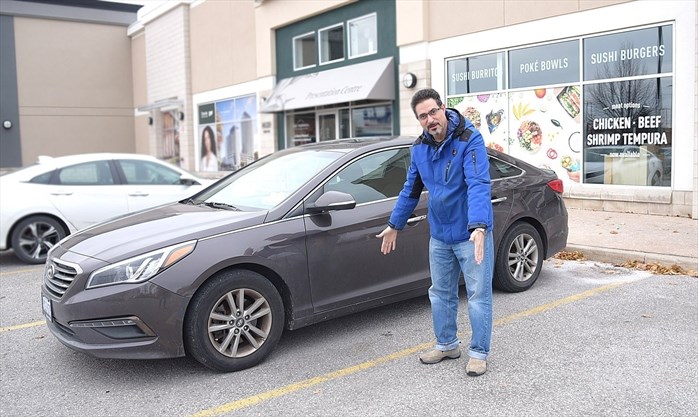Vaughan resident troubled to see car operated via remote control

Susie Kockerscheidt/Torstar
Nathan Cantkier shows where the Tesla was parked by remote control. Cantkier is concerned about the driverless vehicle he witnessed driving unsafely in the parking lot plaza corner of Bathurst Street and New Westminster Drive in Thornhill. He said there was no driver in the car and it came close to colliding with him. Nov. 10, 2019
His second reaction?
Shock.
There was no driver at the wheel.
He had come “face-to-face with no face.” The car that veered into his lane at the Bathurst-New Westminster plaza was driverless.
Cantkier, of Vaughan, said the car had been moving extremely slowly and appeared to be driving out of the parking lot before it came to a dead stop, then slowly headed toward a parking spot.
“I was like wtf? Where is this yahoo going? What a knob! … Only to find there was no driver and I was cussing at no one!”
Cantkier then noticed the driver of the black Tesla was inside the yogurt shop operating it by remote control. He appeared to be using the manufacturer’s Smart Summon app, which gives drivers the ability to direct their vehicle using their phone.
“He was going too slowly. What if someone turned in to the lot at normal speed? This is two-and-a-half tons of metal. It can kill people.”
When he told his wife about the episode later, Lisa Cantkier worried about future road safety for her two sons.
“The concept of driverless cars scares the heck out of me,” she said. “Do we not have enough to worry about on our roads?
“He was operating it from inside the store. How much would he be able to see from there? What might be blocking his view and what about pedestrians that come out of nowhere — how does it impact your response time from that distance?”
Smart Summons is designed to enable vehicles to navigate a parking lot and come to the driver or a destination of choice, as long as the car is within 200 feet and in their line of sight. Drivers can stop the car by releasing the app’s button.
Since the feature was released in October, there have been reports of fender-benders and parking lot chaos.
York Regional Police Const. Laura Nicolle said If an automated vehicle is operating in a way that is significantly unsafe or puts others at risk, or is violating any rules of the road, police should be contacted and will investigate — whether the vehicle is being driven on public roadways or private parking lots.
Tesla did not respond to a request for comment.
Its website said Smart Summon is only intended for use in private parking lots and driveways, adding, “you are still responsible for your car and must monitor it and its surroundings at all times within your line of sight because it may not detect all obstacles. Be especially careful around quick moving people, bicycles and cars.”
Ontario Ministry of Transportation’s Automated Vehicle Pilot establishes rules, monitors industry developments and evaluates the safety of automated vehicles prior to them becoming widely available to the public.
“The Smart Summon feature is intended for use in private parking lots and driveways. As such, the ministry has no plans at this time to update its rules on automated vehicles related to the Telsa Smart Summon app,” said ministry spokesperson Kristine Bunker.
The Cantkiers remain concerned.
“It’s frightening enough with people driving the roads today as it is, with distracted driving, etc.” Lisa Cantkier said. “Unexpected things can happen. … There’s a fine line between driving because you need to, and driving because it’s fun. It’s not a toy.”
SIDEBAR
In January 2016, Ontario became the first Canadian jurisdiction to permit automated vehicle testing on provincial roads.
Under Ontario’s Ministry of Transportation rules, vehicle drivers must be in the driver’s seat at all times monitoring the vehicle’s operation unless approved for driverless testing.
For driverless testing, full human oversight of the vehicle’s functionality is required while it is operating on a public roadway. The overseer can be a passenger on board the vehicle or someone monitoring the vehicle remotely, and must be capable of intervening during the vehicle’s operation to bring it to a safe stop if necessary.
Ministry spokesperson Bob Nichols said these rules apply to both remote-controlled cars as well as computer-piloted.
If testing on a provincial highway, pilot participants must obtain prior approval from the ministry. Pilot participants must also alert local authorities (e.g. municipalities) prior to testing, and indicate where and when testing will occur.
The City of Vaughan says it has not been notified of any automated vehicle pilots taking place there.
These restrictions would not have applied to the vehicle Nathan Cantkier encountered, Nichols said. Parking lots are private property and the conditions for driverless testing are for testing purposes under the Automated Vehicle Pilot on public roadways.
There are currently 11 participants in Ontario’s Automated Vehicle Pilot, testing a total of 13 vehicles on Ontario’s roads, Nichols said.
Tesla is not a participant in the pilot program. The 11 participants include the University of Waterloo, the Erwin Hymer Group, QNX, Continental, X-Matik Inc., Magna, Uber, Aptiv, Logics Academy, University of Toronto and Carleton University.
Source: YorkRegion.com
